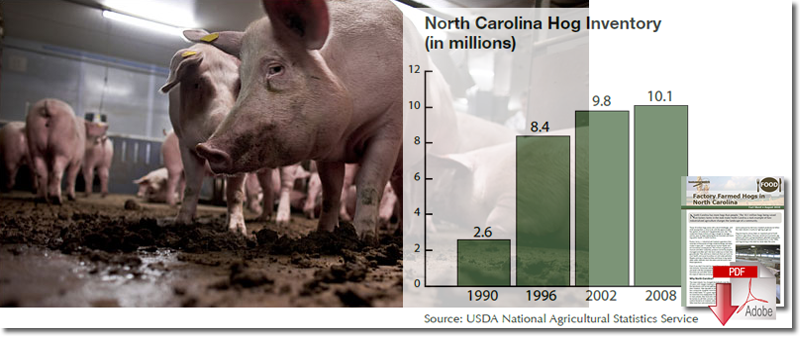Spy Drones Expose Smithfield Foods Factory Farms

A drone video captures shocking aerial footage of several massive facilities that supply pigs for Smithfield Foods.
A drone flew over a pig farm to discover it’s not really a farm, it’s something much more disturbing (view the above video).
Bacon’s a thing these days. Yummy and bad for you - mmmm. But here’s what a drone saw when it payed a visit to some pig “farms” run by the world’s biggest pork producer.
Drones get all kinds of places that can be hard to check out
The owner of this drone, filmmaker Mark Devries, had an idea of what he’d discover here, but still ... whew.
He wanted to get a look at some pig farms operated by Murphy-Brown, a subdivision of Smithfield Farms, far and away the world’s largest pork producer. There are over 2,000 farms like this in North Carolina alone.
As the drone comes over the trees, it comes across a lake.
But that’s no lake at all.
It’s an open sewage lagoon filled with pig feces and urine.
And it’s the size of four football fields.
Beyond the lake are buildings in which thousands of pigs live, often packed in so tightly they can’t even turn around. For months at a time.
It’s unbelievable treatment of a creature believed to be both highly intelligent and self-aware.
Here’s an unforgettable post we shared a while back that shows what happens to animals raised as food.
This is no farm. It’s a factory built for efficiency.
When the pigs poop and pee, it falls through slats in the floor and gets flushed out into the “lake.”
And it gets worse.
The operators of the factory farm have to clean out the cesspool when it gets too full. How do they do it?
They spray pig waste over the fields around the farm - and over neighbors’ homes.
“It can, I think very correctly, be called ‘environmental racism’ or ‘environmental injustice’ that low-income people, people of color, bear the brunt of these practices.”
- Steve Wing, Ph.D., associate professor of epidemiology, University of North Carolina Gillings School of Global Public Health
There are studies showing increased levels of asthma in kids nearby, as well as upper respiratory problems and elevated blood pressure in adults.
Did you know about all this? Not me.
When the filmmaker calls this “among the most bizarre and disturbing environmental phenomena that have ever confronted America,” he’s not exaggerating.
Step 1 in stopping these practices is bringing them into the light - and remember, there are thousands of factory farms like this.
The Trouble with North Carolina’s Factory Hog Farms
Today, more than 10 million hogs are being raised in North Carolina on factory farms – industrialized operations that house thousands of pigs in very small confined spaces and rely on the heavy use antibiotics, artificial hormones, and other chemicals to promote fast growth. These hogs produce 40 million gallons of untreated manure and other waste each day that continue to create serious public health and environmental consequences in North Carolina.
The tons of liquid and solid waste generated by the hogs, which can contain toxins like ammonia, hydrogen sulfide, nitrates, and bacteria, accumulate in open-aired pits (called lagoons) that often overflow or leak into local waterways. As an industry norm, this liquefied hog manure is then regularly sprayed onto nearby agricultural fields less than 100 feet away from family homes, schools and parks where children play, and churches where people worship.
While the constant stench from these lagoons and sprayfields has had a negative impact on the quality of life in communities near these farms, more serious issues have been documented. Studies have shown that communities near these facilities suffer from respiratory problems, anxiety, depression, and sleep disturbances. Nitrates and other chemicals from factory farms that end up in surface and groundwater also threaten the health of nearby communities. Health risks from excessive nitrate exposure include blue baby syndrome, disruption of thyroid function, and bladder cancer.
Manure that has entered waterways can also fuel algal blooms that can deplete oxygen in water and result in the death of fish and other marine life. These are not hypothetical threats - North Carolina’s waters have been polluted repeatedly by waste from hog farms. The worst example on record occurred in 2003 when Hurricane Floyd released 120 million gallons of hog waste into nearby waterways.
It does not have to be this way – the hog industry has changed dramatically over the last few decades and it can change again. A huge number of family farms used to raise the state’s hogs outdoors, allowing them to forage for some of their food, and used their waste as fertilizer. Small and midsized farms anchored robust rural economies, while producing food for North Carolina and beyond. We need to take steps now towards creating a more responsible agricultural economy while protecting the health of North Carolina residents and the environment.
Shutting down the manure lagoons and the spraying of untreated hog waste would address some of the biggest public health and environmental problems caused by these massive factory farms. Ending one of the worst practices employed by these factory hog farms would also be a step towards changing the industrial model of farming and creating a more responsible agricultural economy.
Download the Report: Factory Farmed Hogs in North Carolina
Article Topics
Food & Water Watch News & Resources
Factory Farmed Hogs in North Carolina Spy Drones Expose Smithfield Foods Factory FarmsLatest in Supply Chain
How Supply Chains Are Solving Severe Workplace Shortages SAP Unveils New AI-Driven Supply Chain Innovations How Much Extra Will Consumers Pay for Sustainable Packaging? FedEx Announces Plans to Shut Down Four Facilities U.S. Manufacturing is Growing but Employment Not Keeping Pace The Two Most Important Factors in Last-Mile Delivery Most Companies Unprepared For Supply Chain Emergency More Supply Chain













